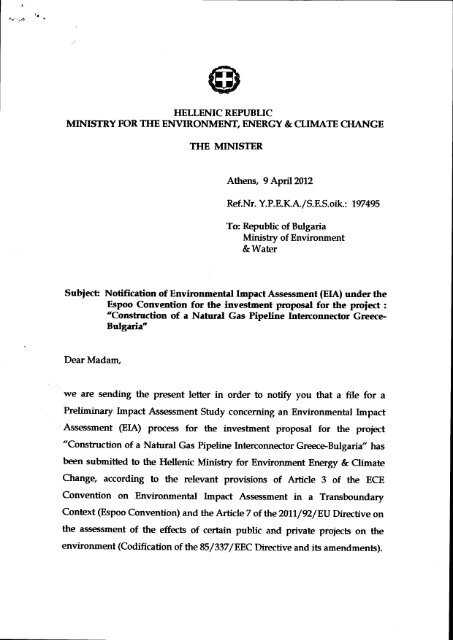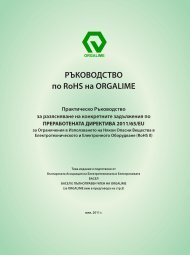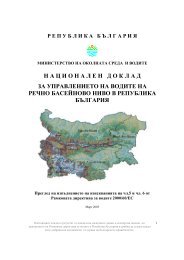I{ELLENIC REPTJBLIC MIMSTRY FOR TIIE ET\TVIRONMENT ...
I{ELLENIC REPTJBLIC MIMSTRY FOR TIIE ET\TVIRONMENT ...
I{ELLENIC REPTJBLIC MIMSTRY FOR TIIE ET\TVIRONMENT ...
You also want an ePaper? Increase the reach of your titles
YUMPU automatically turns print PDFs into web optimized ePapers that Google loves.
tr'-r,P'taI{<strong>ELLENIC</strong> <strong>REPTJBLIC</strong><strong>MIMSTRY</strong> <strong>FOR</strong> <strong>TIIE</strong> <strong>ET\TVIRONMENT</strong>, ENERGY & CTIMATE CIIANGETI{E MINISTERAthens, 9 April2012Ref.Nr, Y.P.E.K.A./S.E,S.oik .; lg7 495To: Republic of BulgariaMinistry of Environment& WaterSubiect Notification of Environmental Impact Assessment (EIA) under theEspoo Convmtion for the investment proposal for the proiect :"Constmction of a Natural Gas Pipeline Interrconnector Greece-Bulgaria"Dear Madam,we are sending the present letter in order to notify you that a file for aPreliminary hnpact Assessment Sfudy concerning an Environmental ImpactAssessment (EIA) process for the investment proposal for the proiect"Construction of a Natural Gas Pipetine Interconnector Greece-Bulgaria" hasbeen submitted to the Hellenic Minisfy for Environment Energy & ClimaEChange, according to the relevant provisions of Article 3 of the ECEConvention on Environmental Impact Assessment in a Transbound"ryContext (Espoo Convention) and the Article 7 of the 2011/y2/EU Directive ontte assessment of the effects of certain public and privab proiects on theenvironment (Codification of the 85/337/EEC Directive and ib amendments).
I?.;-.*.''lThe proponent of the proiect is "ICGB (lrterconnector Greece-Bulgaria) A'D'"It would be very important for us to know whether your country would beinhrested in participating in the EIA process and in entering in bilateralconsultations with Greece about this specific proiectFurthermore, we would like to encourage you to inform us of any particularlysensitive environmental or social issues that might be affecbd in the regionand should be taken into accounlWewouldappreciateifyoucouldletusl.nowthecontactdetailsoftheauthorityorpersoninchargeforsuchmatbrs.Wewouldalsoliketoknowifyou consider necessary to provide specific local data and arrange a contactpoint for the competent environmental authorities'In any case, a positive or negative response will be required from you(whether or not you would like to participate in the EIA process and therelevant consultations) within four (4) weeks upon receipt of this letter'In this directioo you may find attached to our letbr a completed "Format forNoticificationunderArticle3oftheEcEConventiononElAinaTransboundaryContex{,fottheNaturalGasPipelinelnterconnectorGreece-Bulgaria containing all the necessary technical details (a non-technicalsummary, which includes a brief proiect descriptio+ project map andpreliminary information on potential environmental impacts combined withsuitable mitigation measures, as well as additional related information) forthe proposed proiect, in order to proceed with the transboundary EIAprocedure.
MP.EIA/1998/4Annexpage llTable 1<strong>FOR</strong>MAT <strong>FOR</strong>NOTIFICATION LTNDER ARTICLE 3 OFTHE ECE CONVENTION ON ENVIRONMENTAL IMPACTIN A TRANSBOUNDARY CONTEXTNOTIFICATION TO AN AFFECTED PARTY OF A PROPOSED ACTIVITYUNDER ARTICLE 3 OF THE CONVENTIONT. TNPONVATION ON THE PROPOSED ACTIVITY6 Infor-atio. on the nature of the nr9q911! :gtivityType of activity ProPosedConstruction and operation of the natural gasInterconnector Greece - Bulgaria (IGB) berweenKomotiniinGreecea!4!!3l9..2,3g91*9*B--glgaria'The present notification concerns the Greek part,i.e. ftre section between Komotini area and theGreek-Bulgarian borders.The relevant section comprises mainly thefollowing infr astructure :-a pipeline, with an approximate length of 30 km,-the gas Metering Station, at the starting point int
Description of proposed activity (e.g. technologyused)The main activity is the pipeline constructionwhich will be conducted through laying thepipeline below ground at approx. lm below thesurfabe.oDescription of purpose of proposed activityIn respect of the crossing of the main road fromMakasa to Egnatia, the laying of the pipelinebelow it will be conducted through horizontaldirectional drilling (HDD). If the HDD is notapplicable, other appropriate technical solutionswillbe adopted.The pipeline will be desigred and constructedbased on the National, European and Internationalcodes and standards.The construction of the IGB will supply Bulgariawith natural gas from alternative sources such asthe Caspian region and the Middle East.Moreover, IGB will be designed so as to have areverse flow operation (from Bulgaria to Greece).oRationale for proposed activity(e.g. socio-economic, physical geographic basis)Additional information/commentsIGB will be another independent source forsupply of natural gas to the Republic of Bulgaria,which will increase the security of supply andcreate opportunities for gas supply to new regionsthrough which the route will run.Moreover, the geostrategic role of Greece andBulgaria will be reinforced, since the transportedquantities can also potentially supply other Balkancormtries, through existing or scheduledinterconnectors (e. g. Romania, Westem B alkans).The IGB project has been declared as of NationalImportance by both the sovereign Countriesinvolved through Resolution No 615/14.07.2009of the Government of the Republic of Bulgariaand Law 4001/2011 of the Republic of Greece.ii) Information on the spatial and temporal boundaries of the proposed ActiviWLocationThe construction of IGB in the territory of theRepublic of Greece will take place within theboundaries of the Municipality of Komotini, inthe Region of Rodopi.Description of the location(e.g. physical-geographic, socio-economiccharacteristics)The Greek part of the route starts at the IndustrialArea of Komotini and for its first part passesthrough level agricultural areas. The routing areathen becomes hilly and in the last section, beforereaching the Greek-Bulgarian border, it becomesmountainous. The route has been selected in order
to avoid archaeological sites, existing villages orsettlements and to cross the minimum possible offorest areas. In general the route is in rathersparsely populated areas.oRationale for location of proposed activity(e.g.socio-economic, physical-geographic basis)Time-frame for proposed activity(e.g. start and duration ofconstruction andoperation)The approach is to assure the full sustainability ofthe infrastructure with particular care toenvironmental protection by avoiding to themaximum extent possible crossing or passingthrough sites presenting geological orgeotechnical difficulties, and by minimizing itstotal length.The Greek route does not cross anv NATURAprotected area/zone.Front End Engineering Design & EnvironmentalImpact Assessment Study has commenced in2011.It is expected that the Detailed Design andConstruction will be completed by the end of2014.Lifetime of operation - 40 years.Maps and other pictorial documents connectedwith the information on the proposed activityAdditional information/commentsHerewith attached is a map of proposed andalternative(s) route options in relation to theProject.iii) Information on exDected environmental impacts and proposed mitigation MeasuresoScope ofassessment(e.g. consideration ofi cumulative impacts,evaluation of alternatives, sustainabledevelopment issues, impact of peripheralactivities, etc.)The relevant National and European legislation rsapplicable, including the recently voted law401412011. The Preliminary Definition ofEnvironmental Requirements (an activity which isoptional in the new law) has taken place with thesubmission of the Preliminary EnvironmentalImpact Assessment Study (PEIAS).The Environmental Impact Assessment willfollow, considering, among others, the following:allowed land uses; location, design and technicalcharacteristics of the project, during itsconstruction and operation; evaluation ofalternative routes; data of the natural andanthopogenic environment; evaluation andassessment of potential significant impact to theenvironment during both construction andoperation; mitigation measures, in order to delete,reduce and counterbalance any potentialsignificant negative impacts; environmentalmanagement and monitoring; specialized studies,to be performed in the above mentionedEnvironmental Studies.
Expected environmental impacts of proposedactivity(e.g. types, locations, magnitudes)During construction-installation works, the levelof noise is expected to be temporary increased,due to the activities of construction machineryand workers. The operation ofconstructionmachinery is expected to lead to increase of theconcentration of COz in the atmosphere. It is alsoexpected that limited discharge at specifiedsuitable points of used lubricating oils will takeplace.During the construction of the IGB, constructioncorridors will have an expected width of 22m.In the above mentioned are4 the vegetation shallbe temporarily cleared. Following the pipelineinStallation, the reinstatement of the area will takeplace. In azone 5m wide from each side of thepipeline axis, no deep root plants will be allowed.The impact of the construction to the flora isconsidered as not significant, local andpelmanent.Due to the significant volume of ground worksnecessary for the gas pipeline bedding, themechanical effect on soils is the most significantone compared to all the other effects. The impacton soils could be assessedsignificant, local (atconsffuction site), short-term during construction,possible to reclaim and without cumulative effect.Inputs (e.g. raw material, power sources, etc.)During implementation of construction, smallquantities of concrete shall be incorporated. Thenecessary electric energy for welding and otherworks will be provided by mobile dieselgenerators. In general, water will not be used forthe pipeline construction and installation works.Water will be necessary for the performance ofthe hydraulic testing of the pipeline, followingwhich, the water will be discharged in the nearestwater basin.Outputs(e.g. amounts and types of: emissions intothe atmosphere, discharges into the water system,solid waste)During construction of the IGB, the followingtypes of emissions are expected:-dust- during construction works (mainly fromearth digging and reinstating works along thepipeline route and the at the stations)- "nonorganizedsource"-emissions from the engines of constructionmachinery, construction processes andtransportation of raw and other materials,equipment and staff.During construction, transmission pipelines arestress tested (hydrotested) according to standardsEN 1594, EN 12186, EN 12327. Duringhvdrotestins. water does not chanse its volume.
ut its quality deteriorates due to the presence ofconstruction byproducts (corrosion on the internalpipe surface, remains of welding electrodes, soiland other objects). The used water can beclassified as waste water from a technologicalprocess - testing.For example, its volume for zisection of 30 km of 32" is approximately 15.000m3. Following hydrotesting, the used water has tobe disposed off into a flowing stream or still waterreservoir, following its proper cleaning.During the implementation of construction andinstallation works, small quantities of industrialand household waste will be generated, which willnot impact negatively on the environment.During the operation of the Project, no significantimpacts are expected.Transboundary impacts(e.g. types, locations, magnitudes)Therefore, during consffuction and operation notransboundary impact is expected to occur.Proposed mitigation measures(e.g. if known, mitigation measures to prevent,eliminate, minimize, compensate forenvironmental effects)During the reinstatement of the area, the properattention will be given to minimize the impacts,eg the top soil layer in agricultural areas will bekept separately and be used for the top layerduring reinstatement. Reforestation will take placein areas outside the pipeline protection zone, etc.Additional information/comments(iv) ProponenVdeveloperName, address, telephone and fax numbersIProject Company - "ICGB" ADCompany Headquarters: Sofia, Lyulin 2, ,,PanchoVladigerov" BIvd. Jtlb66;Executive Officers:Mrs.Yuliana Dimitrova,Mr. Konstantinos KaragiannakosPostal Address: Sofia-1336, PO.BOX 3,Lyulin2"Pancho Vladigerov" Nl66;Phone and fax: phone: 0035/2193962 37, fax:0035121936 6505;Contact person in Greece:Mr G. Kostopoulos, Deputy Project Manager,tel2l0 2701144(v) EIA documentationIs the EIA documentation (e.g. EIA report or EIS) | The Executive Summary of the PEIAS is herewithincluded in the notification?| attached.
If no/partial, description of additionaldocumentation to be forwarded and(approximate)date(s) when documentation will beavailableAdditional information/comments2. POINTS OF CONTACTO(i) Points ofcontact for the possible affected Party or PartiesAuthority responsible for coordinating activities Greek Ministry for the Environment, Energy andrelating to the EIA (refer to decision I/9, annex) Climate Change- Republic of Greece (Ministry of- Name, address, telephone and fax numbers Foreisn Affairs - Greece)List of affected Parties to which notification isbeins sent(ii) Points of contact for the Parry of originAuthority responsible for coordinating activities Greek Ministry of Environment, Energy andrelating to the EIA (refer to decision V9, annex) Climate Change- Republic of Greece, Special- Name, address, telephone and fax numbers Department of Environment, Director Mr Toleris,Decision-making authority if different thanauthority responsible for coordinating activitiesrelating to the EIA- Name, address, telephone and fax numberstel. 210 - 64L237O. fax2l0-6451914(Through the Ministry of Foreign Affairs )I ACTIVITY IS LOCATEDi) Information on the EIA process that will be applied to the proposed ActivitvaTime schedule The Preliminary Environmental ImpactAssessment Study (PEIAS) has been submitted inNovember 20ll and was communicated by thecompetent Ministry to the relevant Authorities.The replies received so far are positive and apositive consultation is expected to be issued inapproximately I month.Taking into consideration the commentsexpressed to the PEIAS and other data from theFEED, the Environmental Impact AssessmentStudy (EIAS) is expected to be submitted by July2012.lts approval is expected by the end of2012.Opportunities for the affected Party or Parties tobe involved in the EIA processConcerning the PEIAS, the relevant Authoritieshave been requested to express their opinion.Moreover, following the issuance of theconsultation of the competent Ministry for the
PEIAS, the public is informed about it throughannouncements to the press.Concerning the EIAS, the public is informedabout the Project and the relevant Study is madeavailable to them. The public can express itsopinion, through the Regional and MunicipalityCouncils or directly to the Ministry. The relevantcomments, as well as possible clarifications by theOwner are considered by the competent Authoritywhich, in case of approval, defines theenvironmental conditions for the Project.oOpportunities for the affected Party or Parties toreview and comment on the notification and theEIA documentationFollowing the issuance of the Environmentalterms, the public is also informed about them.The administrative Authorities (Municipal,Regional) as well as the public will review andcomment the documentation, according to thelegal provisions:- Following the approval of the PEIAS, a copy ofthe Study is communicated to the local Region.- During the EIAS consultation, the EIAS is madeavailable to the Authorities and the public.- Following the issuance of the EnvironmentalTerms, the relevant Decision is made available ina dedicated internet site.Nature and timing of the possible decisionThe indicative time period for the receipt of theEIA Decision is by the end of 2012.OProcess for approval ofthe proposed activityThe Ministry for the Environment, Energy andClimate Change is the competent authority toissue the EIA decision. The following steps shallbe followed as per requirements of the Greeklegal framework:- Submission of the Report for the PreliminaryDefinition of Environmental Requirements to theMinistry and issuance of the relevant consultationby the Ministry (optional activity, which has beendecided to be followed)- Submission of EIA Report to the Ministry;assessment of EIA Report by the Ministry- Public information to the affectedmunicipalities, in order to express theircomments:- Issuance of final decision bv the Ministrv.Additional informatior/comments
4. IN<strong>FOR</strong>MATION ON THE PUBLIC PARTICIPATION PROCESS IN THE COUNTRY O<strong>FOR</strong>IGINPublic participation proceduresThe EIA Report shall be made available to thepublic. Each citizen can submit his comments,either directly or through the local (regional andmunicipal) authorities. The local authorities willthen issue their consultationExpected start and duration ofpublic consultationThe two Studies (Preliminary Definition ofEnvironmental Requiiements and EnvironmentalImpact Assessment Study) will be made availableto the public.The frst one has been submitted to the competentMinistry at the end ofNovember 201I and thesecond one is expected to be completed withinIuly 2012.A period of 5 months is estimated for the approvalof the EIA, following its submission.Additional information/commentso5. DEADLINE <strong>FOR</strong> RESPONSEDate
2.2.1Executive Summary of the Preliminary Environmental lmpactAssessment Study (PEIAS) for the Greek Section of IGBGeneral ConsiderationsICGB AD is a company incorporated with the scope of financing,developing, building, owning and operating on a longterm basisthe gas interconnector between Greece and Bulgaria (the"GasInterconnector Greece-Bulgaria" or "lGB Project"). Theshareholders of ICGB are the Bulgarian company BEH 50% andlGl Posidon 50% (i.e DEPA 25o/o and ltalian EDISON SpA 25%since they are equal shareholders of lGl Posidon).The IGB buried pipeline will transporrt natural gas over the borderbetween Greece and Bulgaria, connecting the existing KomotiniCompressor Station in Greece with an existing gas pipeline nearthe Bulgarian town of Stara Zagora. The proposed pipeline willmeasure a total distance of approximately 180 Km, (about 30 Kmin Greece and 150 Km in Bulgaria).The design of this bi-directional pipeline system shall be inaccordance with the internationally recognised codes of practice:EN1594 and ASME 831.8, and also in conjunction with BulgarianOrdinances, for the safe transportation of 3bcm/yr of gas initially,with the provision for the future expansion up to a maximumtechnical capacity of 5bcm/yr.The following is a summary of the main components of the project:. High pressure gas transmission pipeline of nominal OD 28'(711,2 mm) or larger according with the FEED betweenKomotini and Stara Zagora in Bulgaria; Greek part about 30Km and Bulgarian Part about 150 Km.. At least seven (7) Block Valve Stations (BVs) along theroute of the pipeline, in compliance with applicable norms,one (1) in Greece and at least six (6) in Bulgaria.. Gas Metering Station (GMS) Komotini and PiggingLauncher Station (PS) in Komotinio Metering and Pressure Reducing Station in Kardjali,Bulgaria;o Metering and Pressure Reducing Station in Haskovo,Bulgaria;Gas pipeline connection along with metering and PressureRegulating Station in Dimitrovgrad Bulgaria;Gas Metering Station (GMS) and Pigging Receiver Station(PS) in Stara Zagora Bulgaria;a Integrated Control and telecommunication systems.a Dispatch Center and operation and maintenance base insuitable location in Bulgaria.a Provision for future compressor facilitiesa Various ancillary facilities to supporthe abovementionedinfrastructure.
IFigure 2.1 Schematic Drawing of the IGB ProjectOftake/AGRsto Kardialiotrbke/AcRsto HaskovoOfftake/AGRSto Dimitrovgradstara z3goftlPSlBVlat the €xisting Komotini 5mGREECE30.skmsffi**aaGas M.tcrinS Sbtion ;aAutomated Gas Retuletion StationNotc : At Dimi$ovgrad, also BHiredlonel naturel gas oow materin8Note : Also includcs Control and Trlacommunication SystrmNote : BV 1 in Greece is an additional Blck Valvc to comply with Bulgarian Ordinance on 6as Valv€ separation should not rxceed 30kms.The present document comprises the Preliminary Environmentallmpact Assessment (PEIA) Study regarding the Greek Part of theIGB Project. In specific, the study covers the part of the pipelinefrom Komotini to the Greek-Bulgarian border, including the GasMetering Station (GMS) Komotini and Pigging Station (PS)Komotini along with all the necessary auxiliary equipment and thefirst Block Valve Station (BVs) that will be installed in the GreekTerritory.The present Preliminary Environmental lmpact Assessment Studyhas a two-fold aim, and this is reflected in the structure and thecontent of this document:o To identify any contentious issues related to the proposedrouting, from the environment point of view.o To provide the basis for the realization of the PreliminaryAssessment of Environmental Requirements Procedure(nnnA in Greeek), which is the first part of theEnvironmental Permitting Procedure according to the latestGreek Law (taw 4014t2011 OEK 2OgtA').ln this context, the study emphasises on important issues that mayaffect the feasibility of the proposed routing or introduceconsiderable cost implications. Such issues are the environmentaldesignations of specific areas, the ecological characteristics andrestrictions imposed by European and National Laws, Regulationsand LocalAuthorities.The study follows the general structure required by the Greekauthorities for the Preliminary ElA. This structure provides for adescription of the affected environment, a description of theproposed project including the alternative solutions, an evaluationof the possibl environmental impacts caused by the developmentand the proposition of mitigation measures for those impacts.
2.2 Pipeline Routing - Alternative Routing SolutionsThe routing of the High Pressure gas pipeline was chosen basedon criteria as the safety of the population, the protection ofecosystems and the terrain structure. These criteria are the sameas those observed in other high pressure gas pipelines designs ofthe existing Hellenic Gas Transmission System, which wasrecently relocated from DEPA and transferred to DESFA S.A.2.2.1Short Recommended Route DescriptionThe Recommended routing of the pipeline has a total length of30745.84m. (K0-K108), beginning at the Metering Station andPigging Station (PS1), that are going to be installed in a commonland plot near the existing Natural Gas Station of DESFA, which islocated in the Industrial Area of Komotini, and ending at theconnection point of the Greek section of the pipeline with the rest(Bulgarian) section of the pipeline at the border of Greece -Bulgaria.With direction from south to north, the routing is locatedconsecutively as follows:Seqment K0-K22 (0-11.Skm):The routing of the pipeline has northwestern direction at first and northern afterwards, startingwestwards from the Industrial Area of Komotini from the MeteringStation and Pigging Station (PS1)"KOMOTINI"that are going to beinstalled in a common land plot near the existing Natural GasStation of DESFA, it continues north from the settlement Fylakas,southern at first and western aftenuards from the settlementThrylorio, eastern from the settlement Roditis and the city ofKomotini and ends between the settlements Karydia and Kalchas,passing through extended cultivated areas of cotton and wheat.The main crossings are with the asphalt road Fylakas - Thrylorio(1.5km), the under study DESFA Greece - ltaly (lGl) natural gaspipeline and the existing Komotini - Thessaloniki natural gaspipeline of DESFA (2.5km), the Old National Road Alexandroupoli- Komotini (5.2km), a stream (9.6km) and at the end the asphaltroad lfaistos - Stylario (10.8km).Seqment K22-K36 (11.5-15.3km): With north western direction therouting of the pipeline passes southern at first and westernaftenuards from the settlement Tychiro, passing through hilly areaof gentle slopes with cultivations, trees and heath parts andcrosses the asphalt road to Tychiro (12.4km), the underconstruction (construction works haven't started yet) New NationalRoad "Komotini - Nimfea - Greek-Boulgarian Border - Axis 75"(13.3km) and the asphalt road Karydia - Pandrosos (14.6km).Seqment K36-K108 (15.3-30.7km): The routing of the pipeline hasnorthern direction, passing western at first and northern afterwardsfrom the settlement Pandrosos, western from the settlementNimfea, from the Block Valve Station (BV1)"Nimfea"(27km), which
will be located 4km about west from the settlement Mytikas, itcontinues western from the settlement Ano Mytikas and ends tothe Greek - Bulgarian border, passing through mountainous areawith trees and heath parts. lt crosses mostly the ravineKarydorema (15.3 & 17.7km) and the New National Road"Komotini - Nimfea - Greekboulgarian Borders - Axis 75" (28km)above a tunnel that has already been constructed.Concerning the administrative structure of the routing, the pipelineis located at the Region of East Macedonia - Thrace, at thePrefecture of Rodopi and at the Municipality of Komotini.2.2.22.2.2.1Short description of alternative routesAlternative Routing 1 (ALT-1)The Alternative routing 1 of the pipeline has a total length of28588.82m., beginning at the existing Natrlral Gas Station ofDESFA, which is in the south western edge of the lndustrial Areaof Komotini and ending at the connection point of the Greeksection of the pipeline with the rest (Bulgarian) section of thepipeline at the border of Greece - Bulgaria.With north western direction, the Alternative routing 1 is locatedconsecutively as follows :Seqment 0-11.1km: The routing of the pipeline has north westerndirection, begins from the existing Natural Gas Station of DESFA,which is in the south western edge of the Industrial Area ofKomotini, continues south at first and west aftenrvards from thesettlement Thrylorio, eastern from the settlement Roditis and thecity of Komotini and ends south eastern from the settlementKarydia, passing through extended cultivated areas of cotton andwheat. The main crossings are with the asphalt road Fylakas -Thrylorio (1km), the Old National Road Alexandroupoli - Komotini(4.4km), a stream (9.4km), the under construction (constructionworks haven't started yet) New National Road "Komotini - Nimfea- Greek-Boulgarian Borders - Axis 75" (10.2km) and at the endthe asphalt road lfaistos - Stylario (11km).Seoment 11.1-15km: With north western direction the routing ofthe pipeline passes eastern at first and northern aftenruards fromthe settlement Karydia, south western at first and westernaftenruards from the settlement Tychiro and ends south easternfrom the settlement Pandrosos, passing throug hilly area of gentleslopes with cultivations, trees and heath parts. lt crosses mostlythe asphalt road Karydia - Pandrosos (14.4km) and at the end astream (1a.7km).Seqment 15-28.6km: The routing of the pipeline has northerndirection, passing western from the settlement Pandrosos,continues eastern from the ancient Byzantine castle at the area ofPandrosos, western from the settlement Ano Mytikas and ends tothe Greek - Bulgarian borders, about 400m western from the end
of the Recommended routing. lt is passing through mountainousarea with trees and heath parts and crosses the asphalt road to thearmy camp of Nimfea at many points and the New National Road"Komotini - Nimfea - Greek-Boulgarian Border - Axis 75" (26.1km)above a tunnel that has already been constructed.2.2.2.2Alternative Routing 2 (ALT-2)The Alternative routing 2 of the pipeline has a total length of30262.13m., beginning at the Metering Station and Pigging Station(PS1), that are going to be installeda common land plot near theexisting Natural Gas Station of DESFA, which is in the IndustrialArea of Komotini and ending at the connection point of the Greeksection of the pipeline with the rest (Bulgarian) section of thepipeline at the border of Greece - Bulgaria.With direction from south to north, the Alternative routing 2 islocated consecutively as follows:Seqment 0-12.2km: With north western direction, the routing of thepipeline starts south western of the lndustrial Area of Komotini, itcontinues south at first and west afterwards from the settlementThrylorio, eastern from the settlement Roditis and the city ofKomotini and ends western from the settlement Karydia, passingthrough extended cultivated areas of cotton and wheat.The main crossings are with the under study DESFA Greece -Italy (lGl) natural gas pipeline and the existing KomotiniThessaloniki natural gas pipeline of DESFA (1.4km), the asphaltroad Fylakas Thrylorio (1.gkm), the Old National RoadAlexandroupoli - Komotini (5.6km), a stream (10.6km), the underconstruction (construction works haven't started yet) New NationalRoad "Komotini - Nimfea - Greek-Boulgarian Border - Axis 75"(11.2km) and at the end the asphalt road lfaistos - Stylario(12.2km).Seqment 12.2-18km: The routing of the pipeline has northerndirection, passes north eastern from the settlement Karydia,western at first and northern afterwards from the settlementPandrosos, passing through hilly area of gentle slopes withcultivations, trees and heath parts. lt crosses mostly the asphaltroad Karydia - Pandrosos (15.9km) and at the end a stream atmany points.Seqment 18-30.3km: The routing of the pipeline has northerndirection, passing western from the settlements Nimfea and AnoMytikas and ends to the Greek - Bulgarian borders, 900m abouteastern from the point that the Recommended routing ends. lt ispassing through mountainous area with trees and heath parts andcrosses mostly the New National Road "Komotini- Nimfea -Greek-Boulgarian Border - Axis 75" (28.4km) above a tunnel thathas already constructed.
Works Area - Routing PhilosophyThe routing-of the High Pressure gas pipeline was chosen basedon criteria as the safety of the population, the protection ofecosystems and the terrain structure. The construction works arecarried out over a Working Width (ROW) of 22 m total for the 28"pipeline (or 26m for 36" pipeline).The works consist of the reception trench opening, performingwelding of pipeline, the lowering, inspection and testing of thepipeline and finally its cover. Especially for woodland and perennialcrops, the work zone will be reduced to 16 m total for the 28'r-36"pipeline.Environmental Aspects & lmpactsThe Environmental Aspects and lmpacts of the project are mainlyconnected with its design and construction phases.During the design (mainly the routing selection) the best solutionshould be selected in order NOT to create problems inenvironmentally sensitive areas, maintainingthe same time theengineering and financial viability of the whole project.The limited environmental impacts of the project occur during theconstruction phase and are presented in Chapter 7. During itsoperational phase the project shall not pose any significantenvironmental threat.It is concluded that with the implementation of careful initial routingdesign in close co-operation with the state and local authoritiesand the provision of all the measures dictated by the InternationalStandards, there shall not be any significant adverse effects fromthe construction works. The guidelines & recommendations of the'local authorities are taken inti consideration in order to minimizethe environmental impacts.The positive consequences of the construction and operation ofthe proposed pipeline for both the environment and the local andnational economy should be noted with emphasis.Protection & Reinstatement MeasuresAfter completion of construction work, the work area will berestored to its original state. The restorations, beyond thehorizontal area of restoration work, concern the restoration of thenatural interseclions / artificial barriers, the protection of slopes, therelocation of any plant systems and finally the restoration of thebeauty and unity of the landscape area along the project route.
2.6 ConclusionsThe Proposed Routing is the best both technically andenvironmentally, compared with two (2) other options that wereexamined. The present Preliminary EnvironmentalmpactAssessment report has examined any impacts that may arise fromthis and proposes the necessary measures of protection. Specialemphasis has been given in the identification of areas that maycreate problems in the development of the project.It is concluded that the project, during its construction andoperation phases, does not cause any significant, long-lasting andirriversible impacts both to the physical and the man-madeenvironment so that a positive Initial EnvironmentalAssessment and Evaluation pronouncement is proposed.
2.7 Summary of Project DataPROJECTNAMETYPEPROJECT SIZELOCATIONPROJECT OWNERADDRESSREPRESENTATIVEInterconnector Greece-Bugaria (lGB)Project - Greek PartHigh Pressure (>25bar) Natural GasPioelinePipeline Diameter: 28" (or larger)Pipeline Lengh : 30.7 Km (ProPosedrouting)Desiqn Pressure : 80 barqRegional Department of RodoPiReqion of Eastern Macedonia & ThraceICGB AD66 Pancho Vladigerov Blvd.,District Lyulin 2,Sofia,Buloaria.Project Manager:Mr. Vanyo SlaveikovTelephone: +359 888567180e-mail: v.slaveikov@gmail.comEIA STUDY TEAMENGINEERDeputy Project Manager:Konstantinos ParthenisTelephone: +30 2102701262e-mail: k.parthenis@depa.grConsortiumPENSPEN Ltd - C&M Ensineerins S.A.ADDRESS99, Pratinou str., 11634 Athens, GreeceTELEPHONE +30-210-7220014FAX +30-210-7220298E-MAILma i l@cmenq i nee rLtlg.grPROJECTEmmanuel KaliorakisRESPONSIBLE
















